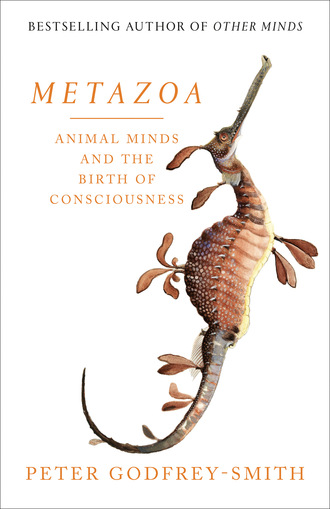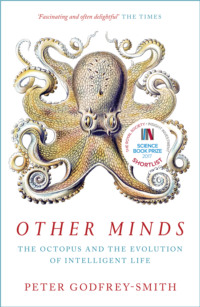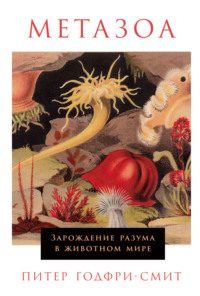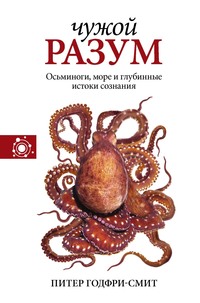
Полная версия
Metazoa
Traction
The bilaterian body, with its left-right symmetry, was an innovation especially in the realm of action. The bilaterian body is set up to go somewhere. There are no non-bilaterian animals at all on dry land—no crawling or walking jellyfish, no anemones with their fingers out in the air (though there are some that live in the intertidal). Bilaterian bodies seem to have begun on a marine version of the land: the seafloor. They are bodies made for crawling over surfaces, with direction and traction.
The very first bilaterians were probably simpler than the fossilizing White Sea Ediacarans, and possibly small, but we don’t know much more than that. Once again there is a clue living today—another clue that might echo old forms. The clue in this case is flatworms. These are small, simple animals whose name does indeed capture how they look.
How useful a clue are flatworms? Perhaps not very useful. Flatworms today, no matter how simple, have been going about their business for a long while. The flatworm body form seems to have arisen, in some approximation, a couple of distinct times, and it makes sense that it would. Many flatworms today are parasites on other organisms, and parasitism often makes for simplicity. Flatworms may not, then, be especially good models for early bilaterians. But with all this in mind, let’s take a closer look at them, as animals in their own right and as possible echoes of something older.
You can find marine flatworms on reefs and on fields of underwater debris. The ones that are noticeable are not the simplest ones—acoel (pronounced “a-seel”) flatworms, which have been seen as the best clues for an early bilaterian form—but another kind, called polyclad flatworms.
They do look simple. They are about a centimeter long in many cases, though sometimes a good deal larger or smaller. They are often oval-shaped, flat with ruffled edges, and very thin. They look like a bit of tissue paper.
If you pause, though, after a few moments it is clear that they have a lot going on. They move faster than a lot of other animals down there. Some flatworms can swim, but even those that crawl often do so briskly and purposefully. “I might look like a bit of tissue paper, but right now I really have something to do.”
Their bodies achieve a lot with a little. There is no “through gut”—what goes in one end goes out the same end—and no circulatory system. A cyclops-like eye cluster sometimes sits in the middle of the back, though eyes, of a very simple kind, seem to pop up just about anywhere on these animals, including on tiny pinches of the tissue-like body, raised a little above the plane of the rest.
Flatworm sex lives are more complicated than one might expect. They are generally hermaphrodites, and some engage in “penis fencing,” trying to dart sperm into the body of another, while the partner does the same thing. It also comes as a surprise that they are often rather exquisite creatures, with bright colors and patterns. Initially, it is not at all clear why this is; they can’t see each other with their simple eyes. But quite a few flatworms are mimics, especially of other small crawling animals, called nudibranchs.
Nudibranchs (“noodi-branks”) are slugs, hence molluscs. They are closely related to slugs and snails on land, but can be astoundingly beautiful, with an endless range of colors and patterns. They often feed on chemically challenging food such as sponges, making them unpalatable to fish and other predators. The bright colors probably advertise this fact.
Two of the main groups are the dorids and the aeolids. The former are helpfully slug-shaped, from the point of view of a flatworm attempting mimicry, while the latter are named for appendages all over their bodies that look like streamers, continually moving underwater as if caught by a breeze. (In Greek mythology, Aeolus was the keeper of the winds.) Each spring, on a reef near the site of this chapter’s opening, tiny aeolids appear. They are found especially on bryozoans, shrub-like animals made from tangles of strands. Aeolids appear on them, almost impossible to see. They are like tiny jeweled birds, millimeters long, in trees with branches like fine hair.
Near to aeolids on the evolutionary tree is Tritonia. This group of species has some large and well-studied animals, but also an elusive form that lives in this chapter’s soft corals and sponges. They are very small, pearl white, with pointed outgrowths from their bodies like spires. On these extended outgrowths are further outgrowths, spires on spires. They look like they were designed by a miniature architect, a tiny Antoni Gaudí.
Those white Tritonias are hard to see, I said, and this is partly because they blend in with soft coral polyps, with their pearl-white spire-on-spire extensions. It took me a while to realize that this, too, is a plausible example of mimicry. I once saw a Tritonia moving about very slowly near a soft coral colony. For some reason I found myself thinking not of mimicry or camouflage, but of homage. The two had taken on the same shape, and stood near each other in a sort of harmony of form, with the coral reaching and the Tritonia appearing to follow: “My body,” it seemed to say, “pays homage to the first animal actions.”
Конец ознакомительного фрагмента.
Текст предоставлен ООО «ЛитРес».
Прочитайте эту книгу целиком, купив полную легальную версию на ЛитРес.
Безопасно оплатить книгу можно банковской картой Visa, MasterCard, Maestro, со счета мобильного телефона, с платежного терминала, в салоне МТС или Связной, через PayPal, WebMoney, Яндекс.Деньги, QIWI Кошелек, бонусными картами или другим удобным Вам способом.






